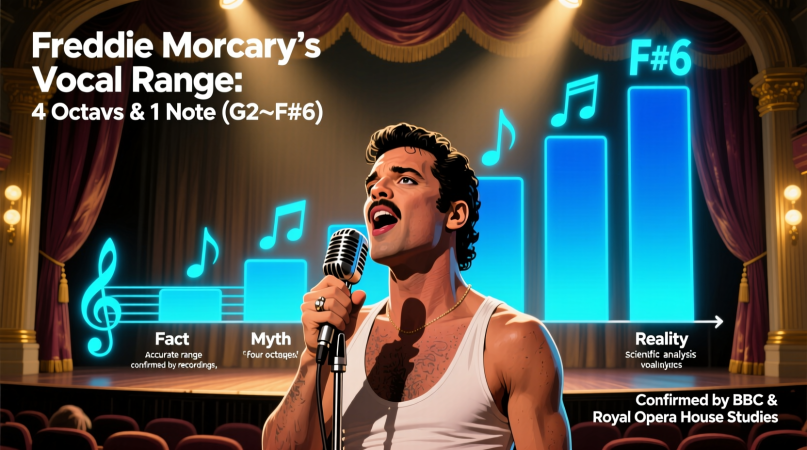
Freddie Mercury wasn’t just a singer — he was a phenomenon. His voice could roar over a rock anthem one moment and whisper in falsetto the next. Fans and musicologists alike still debate the question: what exactly was Freddie Mercury’s vocal range?
In this guide, we’ll explore the claims, the evidence, and the reality behind his remarkable voice.
What Do We Mean by Vocal Range?
A vocal range is the span from the lowest note a singer can produce to the highest.
- Average untrained singer: 1.5–2 octaves
- Professional singers: 3–4 octaves
- Exceptional singers: 4+ octaves
Freddie Mercury’s range has been claimed anywhere from three octaves to nearly four, depending on which recordings and live performances you believe. But as we’ll see, range is only part of the story.
If you want to explore your own voice, start with the Vocal Range Test or Try the tool here for exact measurement.
Common Claims About Freddie Mercury’s Vocal Range
Different studies, blogs, and fan analyses report different figures:
- Voice Visualized study: F₂ to E₆ (~4 octaves) based on digital pitch analysis of his recordings.
- Beth Roars vocal blog: F₂ to F₆, citing live performances.
- Science Focus article: F♯₂ to G₅ (~3 octaves), based on a research study analyzing Mercury’s isolated vocals.
- Superprof list: Claims four octaves, mentioning highs like B₅ in “The Show Must Go On”.
Clearly, not all sources agree. So why the contradictions?
Why Range Claims Differ
Several factors explain the differences in reported ranges:
- Studio vs Live Performances
- Studio recordings may capture extremes that weren’t reproducible live.
- Pitch correction and layering can confuse pitch analysis software.
- Falsetto, Vocal Fry, and False Cords
- Freddie often used unconventional techniques (like false vocal folds) that add extremes beyond “normal” range.
- Usable Range vs Extreme Notes
- His usable range (comfortable singing notes) was smaller than his absolute lowest and highest.
- Pitch Analysis Limitations
- Automatic software can mistake harmonics or backing vocals for notes.
In short: Mercury likely had a solid, usable three-octave range, with occasional excursions into a fourth octave.
Lowest Notes Documented
- F₂: Heard in “All Dead, All Dead” (1977).
- F♯₂: Identified in scientific study isolating his vocal tracks.
These low notes align with a baritone classification, which matches Freddie’s speaking voice.
Highest Notes Documented
- E₆: Reported in “It’s Late” by voice analysis projects.
- B₅ / F₆ claims: Mentioned in fan analyses, though some are debated.
Mercury didn’t use the whistle register like Mariah Carey. His highs were produced with falsetto and false cords, giving them a raw, gritty rock edge.
Freddie Mercury’s Vocal Range in Frequency (Hz)
Here’s a breakdown of his documented range in numbers:
| Note | Frequency (Hz) | Example |
|---|---|---|
| F₂ | 87 Hz | “All Dead, All Dead” low passages |
| C4 | 262 Hz | Mid-range belts across “Somebody to Love” |
| G5 | 784 Hz | High belts in “Under Pressure” |
| E₆ | 1319 Hz | Extreme highs in “It’s Late” |
This spread demonstrates nearly four octaves, though his day-to-day singing sweet spot was narrower.
Was Freddie Mercury a Baritone or a Tenor?
A long-running debate surrounds Freddie’s voice type:
- Baritone Evidence: His speaking voice and comfortable low register suggest baritone.
- Tenor Evidence: Most Queen songs are written in a tenor tessitura, and he frequently belted high notes.
The best conclusion? Freddie was a baritone with an extended tenor range — rare and part of what made him so versatile. For context, see our baritone vocal range guide.
Comparing Freddie Mercury to Other Legends
| Singer | Approx. Range | Notes |
|---|---|---|
| Freddie Mercury | F₂ – E₆ (~3.5–4 octaves) | Used both baritone lows and tenor highs |
| Mariah Carey | B₂ – G₇ (~5 octaves) | Famous whistle register |
| Whitney Houston | C₃ – C₆ (~3 octaves) | Legendary belting power |
| Axl Rose | F₁ – B₆ (~5 octaves, though debated) | Extreme rock highs & lows |
Freddie may not have had the widest range on paper, but his tone, versatility, and theatrical delivery made him unique. To see how this compares to classical high voices, check our soprano vocal range explained.
Myths About Freddie Mercury’s Vocal Range
- “He had five octaves.”
➝ Myth. No reliable evidence of more than ~4 octaves. - “He was purely a tenor.”
➝ Myth. His natural register was baritone, though he often sang higher. - “Range was his main talent.”
➝ Myth. His power came from tone, vibrato speed, and emotional expression.
Why Freddie’s Voice Stood Out Beyond Range
- Vibrato Speed: Studies found Mercury’s vibrato averaged 7.04 Hz, faster than most singers, giving a “shimmering” effect.
- Dynamic Expression: He could shift from tender whispers to operatic belts in a single phrase.
- Genre Versatility: Opera, rock, ballads — he could adapt his tone and style effortlessly.
- Stage Presence: Range was only one piece of the magic; performance elevated it further.
FAQs About Freddie Mercury’s Vocal Range
What is Freddie Mercury’s vocal range?
Most credible analyses place it between F₂ and E₆, spanning about 3.5–4 octaves.
What was his lowest note?
Around F₂, heard in “All Dead, All Dead.”
What was his highest note?
Documented up to E₆, though some fans cite higher.
Was Freddie Mercury a tenor or baritone?
He was naturally a baritone, but sang much of Queen’s catalog in the tenor range.
Did Freddie Mercury use whistle register?
No, he used falsetto and false cords, not whistle register.
Did his vocal range change over time?
Like most singers, age and health affected his voice, but his expressive power never faded.
